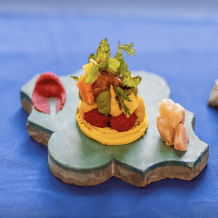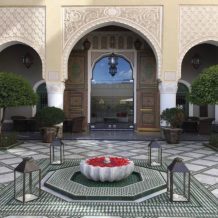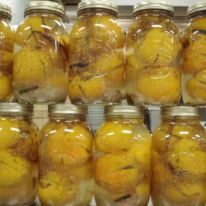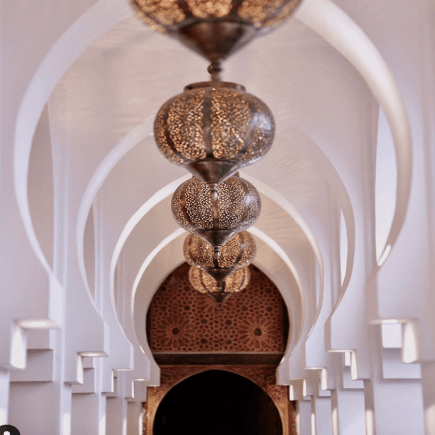
13 Moroccan Holiday Gift Ideas, Shop with Inspiration
Moorish and Moroccan architecture has long inspired architects and designers from around the world. In recent years, Morocco’s booming tourism is attracting globe trotters. They visit and share images and stories of the country’s talented artisans, craftsmen, weavers, pottery makers, and tailors. These reports have caught the attention of magazines like Vogue and are trending on thousands of influential social media accounts. In September 2010, House Hunters International, a show with a global audience of 97 million viewers, followed a family into the Marrakech media. They were on an adventure to restore an old riad in the historical medina. Since around this time, the UNESCO recognized site began inspiring other creative and aspiring designers. Today there are dozens of stories appearing in Haute Couture magazines and many articles about the talented individuals who visited and launched Moroccan inspired brands, fashion lines, and small businesses.
Particularly in the souks of Marrakech’s world-renowned Jemma El Fna square, travelers can meet the talented artisans able to create any design. Whatever you dream up, they can bring to life. As a result of these possibilities, both large and small companies have started selling Moroccan goods worldwide. Companies like Imports from Marrakesh sell their collection of Beni Ourain carpets, colorful poufs, lanterns, Marrakech tile samples, and home accessories both online and throughout showrooms in New York, Los Angeles, Boston, Chicago and even Australia, Scotland and Hong Kong. Other US or UK based small retailers like Moor Morocco, Zyne, and Souk and Soul travel Morocco to work closely together with local artisan partners. They aim not only to make profits but also to give back to the Moroccan community. They want to empower women, children and help close economic gaps. They distribute Moroccan merchandise that is both ethically sourced and locally made.
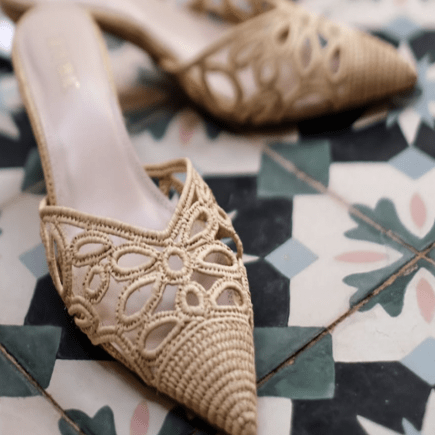
13 Moroccan Inspired Gift Ideas in Moroccan Souks and Marketplaces.
1. Moroccan Babouche
These easy to wear Medieval style slip-on shoes first appeared during the 3rd century AD. The Moroccan babouche comes from the Arabic ‘babush’ or Persian ‘papush’. Inspired by the open back sandal, the focal point of the babouche is its exaggerated point at the toes. This, along with its ultra-soft design is said to reflect the fact that its wearers (often monarchs and 17th-century french courtiers) cared excessively about their lifestyle and their appearance. In recent years, the babouche has been reimagined by designers who have turned the Moroccan slipper into chic footwear. They reinterpret babouche utilizing modern leather, velvet, embroidery, and other local materials. Babouche designer who is a Manchester native Kate Moor created a line after stumbling upon a coup de foudre in the Marrakech medina. She was inspired to launch Moor Morocco. The colors and stories from her visits to Morocco’s seaside town Asilah and trips to the Fes medina, where she discovered the blue-green zellij tile, are reflected in her babouche patterns and styles. The flats are hand-made from buttery cow-sheep interior and have a camel-sole leather slip made by the artisanal Baqali family in the Rabat-Salé souk. “We only work with small ateliers and suppliers to ensure that we are contributing to the local economy,” said Kate.
Other luxury babouche footwear brands like Zyne also design easy to wear contemporary babouche. Like Moor Morocco, they employ sustainable practices. The brand was started by Casablanca born Moroccan designer Zineb Britel and has a zero-waste policy. They use natural materials whenever possible. Zyne footwear has been featured in magazines like L’Officiel Paris, Vogue, Harper Bazaar Arabia, and Oprah. During her visit to Morocco in February 2019, Duchess of Sussex Meghan Markle met with Zyne brand founders and selected an elegant velvet blue babouche and a kitten heel as an addition to her collection.
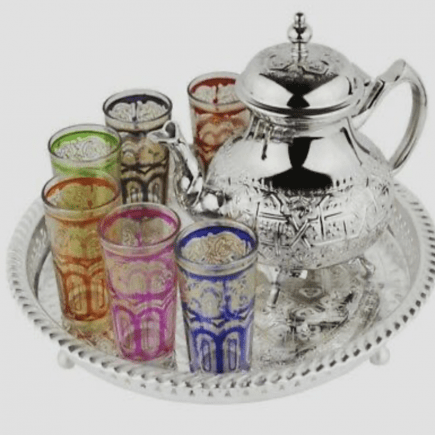
2. Moroccan Tea Set, Tea Pot and Tea glasses
There is an ongoing debate as to whether the Moroccan mint tea was imported by the indigenous Amazigh people from Asia or if it was introduced by Queen Anne Stuart to help free British prisoners. What is undeniable however is that in Morocco, mint tea is consumed up to 30 times a day. The “Berber Whiskey” is offered to welcome guests into homes, shops, visits to an apothecary, or check-ins into a Moroccan hotel or riad. Tea drinking in Morocco is ceremonial and can be compared to how the Japanese or Chinese enjoy tea. The water is boiled separately and then strategically poured over the gunpowder to extract the “essence of tea.” This helps bring out the medicinal and aromatic qualities of the mint and herbs chosen.
Given how important consuming tea is in Morocco, it is not surprising that teapots and tea glasses should be well made. Stainless steel and brass silver are considered the best materials for Moroccan teapots. They are more durable and some families have used the same teapot for over 50 years. The less inexpensive teapots, are available yet best to serve as decorative pieces given they emit harmful chemicals. When selecting a teapot, it is important to make sure that it is heat resistant. Another criterion to consider is the size. For large families, a teapot should be able to hold a liter of water, however for 2-3 people, a smaller 16 oz. the size will be sufficient. Some of Morocco’s best teapots are handcrafted in Fes, Morocco’s most intellectual and cultural capital.
Moroccan tea tastes best served in delicate glass teacups. A wide variety can be found in the souks and are hand-painted by local artisans. The tea sets are served on beautiful silver trays with traditional engravings. Little Moroccan Things has a nice collection of teapots.
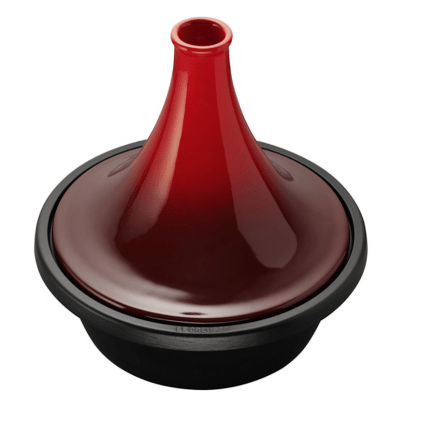
3. Moroccan Clay Cooking Tagine
Some travelers to Morocco confuse a tagine with being a Moroccan meal. The cone-shaped clay pot is actually a cooking vessel used to serve traditional Moroccan dishes. These include chicken with preserved lemon peel, lamb and or beef with prunes, classic fish tagine with chermoula and vegetables, or Berber tagine and vegetables. Historically North African nomadic tribes used the tagine as a “portable oven.” As these tribes often relocated, it was helpful to have an easy to transport cooking device.
Tagines come in two varieties: glazed and unglazed. Slightly experienced cooks wishing to add an earthier and more aromatic flavor to their meal often prefer the unglazed tagine. In Morocco, the best quality tagines are made out of clay whereas lightweight aluminum ones are decorative.
As Moroccan culture, fashion, and flavors continue to spread globally, companies such as Williams and Sonoma and Le Cruset are making tagines accessible without the need for customers to import them from Morocco. Le Cruset uses excellent materials like cast iron and steel to extend the quality and even cooking the surface of tagine pots.
When shopping for a tagine, it is important to consider how many people you will serve. If you have a family or 4-6 people, it is advisable to invest in a large tagine. Similar to pressure or slow cooker, this cooking vessel can be used for simmering well-spiced dishes and creating a variety of meals.
Travelers to Morocco will find tagines sold at souks and pottery cooperatives throughout the country. Some of the best pottery stops can be discovered in southern Morocco, between Ouarzazate and Zagora. Artisans in the Marrakech and Fes medinas also produce high-quality earthenware tagines.
4. Moroccan Lanterns
These traditional hanging lamps (or fanoos) have a rich history originating from African, European, Persian and Indian cultures. The lanterns are made from materials such as wrought iron metal to tinted glass, brass, and silver. The most popular colored window panes found in Moroccan lanterns red, blue and amber. The red, and most popular, was once original Iraqi glass yet today often imported from China. Combination shades of yellow, red, orange, green, and red are available. Whether minimally decorated or elaborate in arabesque techniques, all Moroccan lanterns evoke an effervescent “under the stars” Arabian night effect.
Moroccan luxury riads and hotels such as La Mamounia Hotel and La Maison Arabe, formerly owned by Prince Fabrizio Ruspoli, boast some of the most memorable elegant lanterns. Those featured in La Maison Arabe are the work of Yahya Roach, a well known Moroccan lighting designer. Moroccan lanterns come in unique shapes ranging from pentagonal to octagon bases with dome crowns. They can be as small as candleholders or occupy the space of an extravagant chandelier. Moroccan lamps are also used as wall fixtures.
5. Moroccan Beauty Products
If you ask a Moroccan woman or man what their favorite beauty product is, you are bound to hear that it is Argan oil. For centuries the indigenous Amazigh has extracted the oil from the Argan tree for use in local cuisine and beauty remedies. The Argan tree is known for thriving in the Essaouira and Agadir’s windy, humid, and mixed-heat coastal climates. It is also strong enough to survive temperatures that reach over 110 degrees. The Argan tree’s resilience is the reason it has many therapeutic benefits.
Travelers to Morocco that wish to purchase cold-pressed Argan oil beauty products can do so at reputable women-run cooperatives along the road to Essaouria or Agadir. Visitors can watch the cold oil extracting process. Traditional Moroccan women sit on the floor cracking Argan nuts and grinding them by mortar and pestle. These products make exceptional gifts to bring home.
Additionally, as beauty companies worldwide recognize Argan’s benefits, the oil is being infused into hair and skin care collections. In Morocco, the three trusted companies that make and sell Argan products are Nectarome, Les Sens Marrakech, and The Moroccans; all three ship internationally. Outside of Morocco, the US-based Moroccan Oil brand sells a range of high-quality products for the hair and body. These include revitalizing gel-based scrubs containing Argan shell powder and hydrating shampoos with antioxidant-rich Argan oil vitamins to help manage smoothness and shine. Argan Vitamin A helps combat free radicals and retain moisture while Vitamin E is rich in tocopherols, fatty acids, and antioxidants. A recommended holiday gift is an argan oil and body cream set from Moroccan Oil.
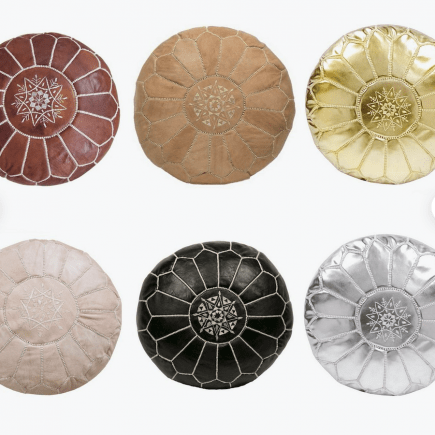
6. Moroccan Poufs
These leather and fabric-stitched pieces serve as perfect for, cozy seating arrangements. The Moroccan pouf is stylistic and chic; the perfect low floor seating options to any room. Most poufs are firm and round and therefore make excellent side tables, stools, or footrests. In Morocco, families often bring out poufs for guests to sit on when enjoying mint tea together. Poufs can be purchased in all of Morocco’s Imperial Cities within the historic district, the medina. Some come filled however similar to a pillowcase, many are sold empty. Ready to use poufs are often stuffed with camel hair, however, old clothing and newspapers also work well. To ensure that the pouf keeps a desirable structure, it is important to not leave air pockets and spaces.
Aside from their practicality, poufs are well decorated with unique Islamic patterns and come in a wide array of colors ranging from camel, rose, teal blue, gold, hot pink and Bordeaux. They bring glamour and add an exotic décor element to a room. As celebrities like Chrissy Teigen launch, Marrakech inspired kitchen and home goods lines at Target, Moroccan inspired decor continues to take center stage. Poufs are easy to find in the United States at trending home stores like Zara and Anthropologie.
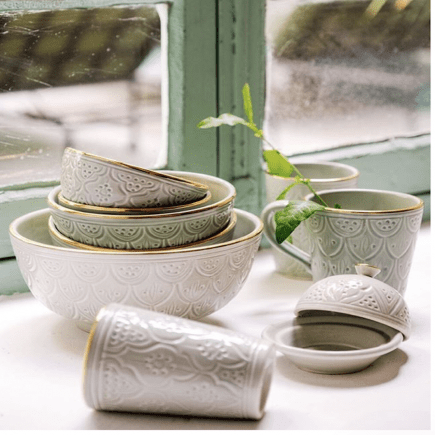
7. Hand-painted Moroccan Ceramics
From Morocco’s deep southern roots to its northern Riffian mountains, talented artisans work to create pottery aimed to brighten up homes. These charming cups, plates, and bowls are hand-painted and embellished with vivid colors, geometric patterns, and other floral designs. As the world’s top chefs have demonstrated, an excellent food presentation served on nice tableware is key to a memorable meal. Chabi Chic is one of Marrakech’s leading concept stores that offer hand-painted, contemporary ceramics. The boutique carries a variety of high-end kitchen and serving pieces along with other unique goods. Many of Chabi Chic’s pieces feature Zwak design. Zwak is inspired by a Moroccan hand embroidery technique using gold and silver thread. Traditionally, Zwak is used to adorn caftans.
Ceramics and kitchen must-haves are a cornerstone of Chabi Chic products. Shop owners Vanessa Di Mino – the artistic director- and Nadia Noël- head of international sales- first created their concept around an innovative line of dishes. They drew Moroccan striped patterns then commissioned local craftsmen to make their drawings. Chabi Chic is the perfect blend of authentic and trendy. Since 2013, the company has attracted shoppers interested in home decor, mini-furniture, and kitchen accessories. Chabi Chic employs local artisans. The brand also regularly exhibits trade shows in Paris, has 4 stores in Marrakech, and over 200 points of sale around the world. They ship internationally.
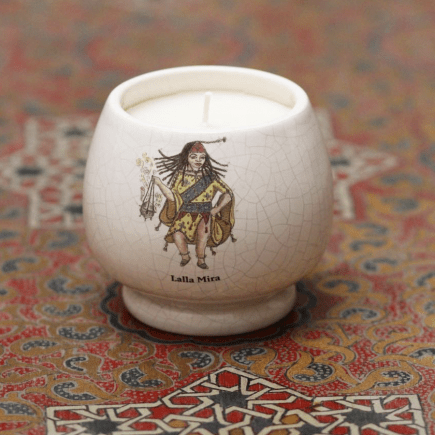
8. Moroccan Aromatic Oils and Candles
Morocco is known for its abundance of natural resources, herbs, plants, and aromatic spices and scents. As a result, many apothecaries and concept stores have taken the opportunity to create candles, aromatic oils, and other fragrances. Among the most popular scents is the orange blossom, and emblematic of Morocco. Morocco’s gardens are lined orange trees. Orange blossom water and a variety of scented fragrances are available today in everything from lip balms, to hand creams, oils, incense sticks, and candles. Other Moroccan aromatic goods include scented Jasmine, a feminine with floral tones; the Verbena, a refreshing tea leaf-inspired blend; Oud, a slightly heavy and exotic aroma; and the Oriental, a woody and warm fragrance that re-energizes the body.
A Casablanca based brand that specializes in high-quality candles is Ulili. The candles are composed of vegetable and beeswax sourced from Morocco’s Ant-Atlas Mountains. Shop owner Omar Benjelloun discovered perfumer, Marianne Nawrocki, to make exclusive scents for the candle company. Their candles incorporate Morocco’s diverse geography and people. M’goun, a blend of wild blackberry, Damascus Rose, and geranium was labeled after the (M’goun) the second-highest mountain in Morocco.
Ulli’s brand story also incorporates Moroccan traditions. Its signature symbol is a perfumed hand that resembles the superstitious Hand of Fatima. According to Islamic legend, Fatima’s hand attracts luck, abundance, and protection. The illustrations for the candles are created by Zineb Benjelloun, a talented young Moroccan artist. Benjelloun researched the country’s traditional games and legends to incorporate Moroccan heritage into the Ulili brand image.
The candles are handmade in the Ulili workshop. To promote ethical business practices and stimulate the Moroccan economy, Ulili collaborates with Moroccan artisans. These include ceramic craftsmen in Tangier, candle lid makers in Essaouira, and a Moroccan master olive oil soap maker.
9. Berber (Amazigh), Moroccan Silver Jewelry
The Amazigh are the indigenous people of Morocco with a culture rich in history and the arts. Wood carving, brass, ceramics, food, and jewelry.
An ideal way to discover Berber, Moroccan culture is to take a cooking class or exploring artisan ware in Berber villages. Jewelry that is produced often tells a story about the Berbers 4,000-year-old history. The Berbers account for approximately 12 million people in Morocco, which is composed of nearly one-third of Morocco’s population.
Two brands that make high-quality Amazigh jewelry is Yelli Jewels and Stone Stories. Yelli Jewels produces accessories from a hand made silver from Tiznit. Their pieces can be best characterized as having a mix of elegant designs with a touch of rock and roll. The iconic Amazigh spiral and triangle shapes are found in many of Yelli’s earring designs.
Stone Stories is another Amazigh jewelry brand created by Moroccan Dutch designer Fatima Essahsah. The young entrepreneur travels to the Ourika Valley to collaborate with artisans who use ancient Berber materials like silver, jade, shell, and amber.
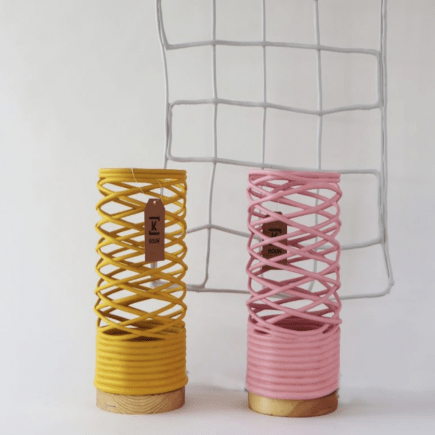
10. Up cycled Moroccan Goods
Morocco has become known for creating sustainable and goods using ethical practices. These initiatives are under King Mohammed VI’s Green Morocco Plan and aim to stimulate employment, improve literacy, boost the farmer’s profits, open doors for women, and inspire entrepreneurship. As a result of these ethical and inclusive practices, several small businesses have integrated upcycling techniques into their brands. Among them is Koun, a social integration company that employs a combination of fabrics, plastics, paper, and cardboard and transforms them into simple everyday home items. Koun is a nonprofit that collaborates with Casablanca’s youth to encourage innovation and job employment. For travelers who want to bring back functional art or seeking a good-for-the-environment-gift, a Koun is a good place to start. The brand can be found in Casablanca and Marrakech based concept stores.
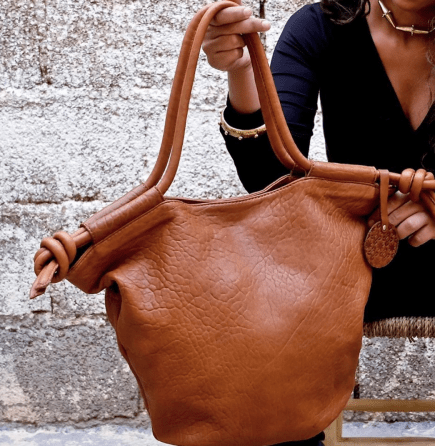
11. Moroccan Leather Bags
A bucket list shopping item for the holiday season that can be found in almost any city in Morocco is a great leather bag. Tanneries like the 11th-century Chouara in Fes sells a variety of leather goods such as shoes, jackets, luggage, and handbags. The most notable leather hides come from cows, sheep, goats, and camels. These skins are soaked in a white liquid that combines cow urine, pigeon feces, quicklime, salt, and water. Although the concoction sounds less than appealing, they soften the hides and prepare them for coloring. Vegetable dyes are made from natural ingredients such as the poppy flower saffron, indigo, and mint leaves, each offering a rich color.
Shopping for leather bags and accessories in Morocco is exciting because the goods available are limitless and also reasonably priced. While not all Moroccan leather goods are created equal there is are a wide array of products offered. Many Moroccan concept stores carry fashionable and quality leather bags. Although the prices might be higher than in a souk, the value is often of exceptional quality. A boutique, leather bag designer worth discovering is Hamimi, a brother and sister brand. Alex is based in Brisbane and Rebecca in Marrakech; who works with a team of local Moroccan artisans and brings the duo’s ideas to life. Recently, they launched the Hayat collection, meaning “Life” in Arabic. The bags are designed for the carefree and practical consumer and come with signature, arabesque embossed charms.
To support the local Moroccan industry, Hamimi has partnered with women in a village outside of Marrakech. Their handbags are made using traditional artisanal methods. The Sarma collection employs the Moroccan Sarma stitching technique, inspired by patterns used on classic Moroccan kaftan belts.
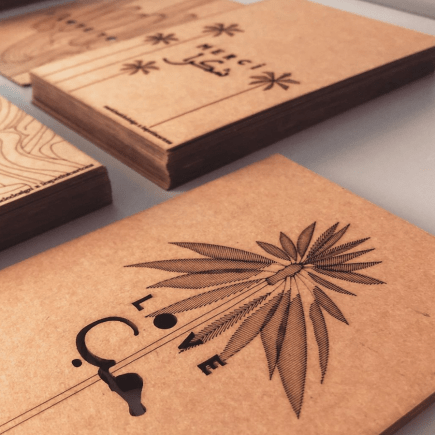
12. Hand Carved Moroccan Postcards
A fun and easy alternative to the classic postcard is a hand-carved one. Taking the postcard to a new level is Marie Bastide, a French Parisian architect turned soulful Marrakech medina photographer. Her gallery in the French Gueliz neighborhood sells her original hand-drawn Red City inspired postcards. Her sketches are sent to talented medina artisans who then print them onto luxurious cardboard. They can be purchased in her shop or online at Les Petits Cartons.
13. Moroccan Wines
Morocco is a well-known wine producer. As a former protectorate of France, this North African country has become a wine mecca. The country is divided into 5 wine regions: East – Meknes, Fes, North – Rabat/Casablanca. Among them, 14 have an Appellation d’ Origine Garantie (AOG) status. One of the most visited Moroccan wine destinations is Meknes. The city has been affected by the Spanish and Portuguese, two of the world’s most famous wine producers. The Portuguese also brought their grapes to other areas of Morocco like El Jadida, Safi, Azemmour, and Essaouira.
Meknes has two well-known and respective wineries, Château Roslane and Domaine de la Zouina, Essaouira also has a Moroccan winery called Domaine du Val d’Argan whose lush vineyards span 1,500 hectares and is admired for its red, white, and rose wines. High-quality Moroccan wines can be purchased between $12-30 USD. The most enjoyable way to shop for Moroccan wines is to visit the vineyards; many will ship internationally. There also spirit shops located throughout Morocco’s Imperial Cities that offer a wide range of wines


